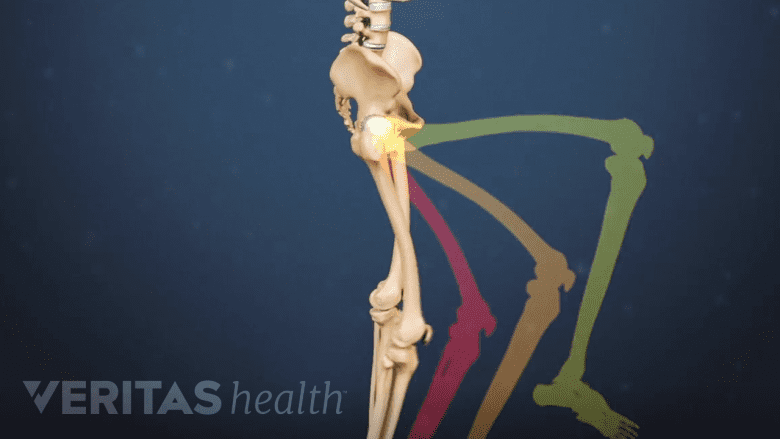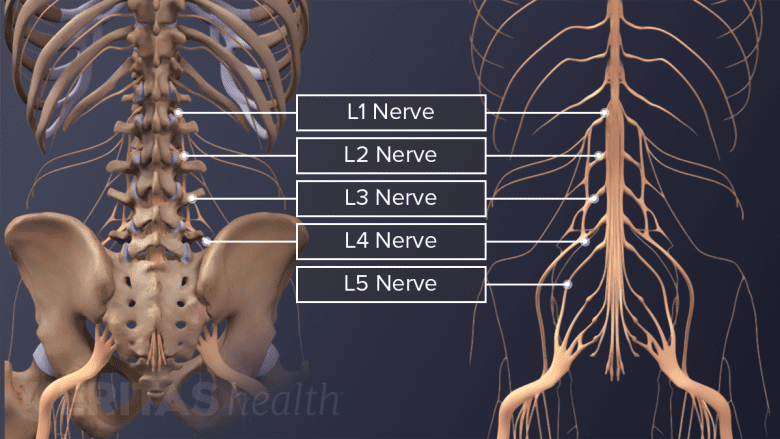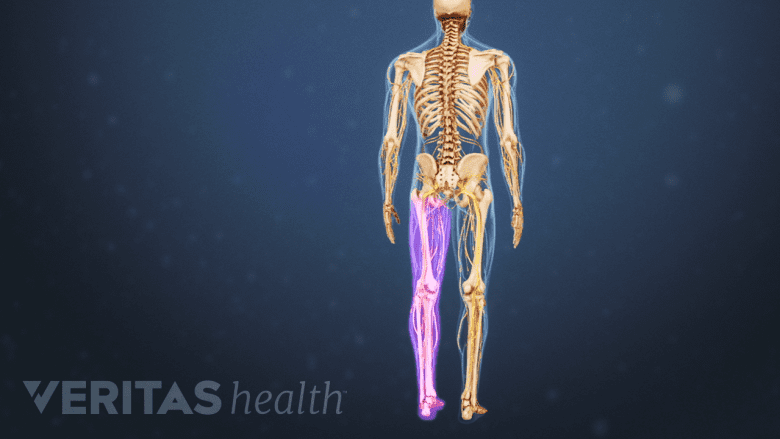Continued nerve pain in the leg after decompression spine surgery can be treated, and for the treatment to be successful, the correct cause of the post-surgical leg pain needs to be identified.
The goals of decompression surgery are to relieve leg pain and neurological symptoms by surgically decompressing a nerve root in the lower spine. The most common types of decompression spine surgery are:
- Microdiscectomy
- Endoscopic discectomy
- Laminectomy (open decompression)
- Unilateral laminotomy
- Foraminotomy
Most patients experience immediate relief from leg pain following the surgery; however, it is possible for leg pain and neurological symptoms to continue after the surgery, as is explained in this blog.
In This Blog:
How long leg pain takes to heal after decompression spine surgery
With the use of conventional open surgical procedures, it is common to experience pain lasting for three days following lumbar decompression surgery (minimally invasive methods generally have shorter recovery times).1Bajwa SJ, Haldar R. Pain management following spinal surgeries: An appraisal of the available options. J Craniovertebr Junction Spine. 2015 Jul-Sep;6(3):105-10. doi: 10.4103/0974-8237.161589. PMID: 26288544; PMCID: PMC4530508. After this period, post-surgical leg pain consistently declines with time.
A few key attributes of leg pain and numbness following decompression spine surgery are outlined below:
- In general, leg pain after a decompression surgery resolves faster than leg numbness.2Zou T, Chen H, Wang PC, Sun HH, Feng XM. Predictive factors for residual leg numbness after decompression surgery for lumbar degenerative diseases. BMC Musculoskelet Disord. 2022 Oct 13;23(1):910. doi: 10.1186/s12891-022-05848-y. PMID: 36224568
- The small nerve fibers (C fibers) heal within 6 weeks of surgery, and pain or sensory disturbances transmitted by these nerves improve significantly around this time.2Zou T, Chen H, Wang PC, Sun HH, Feng XM. Predictive factors for residual leg numbness after decompression surgery for lumbar degenerative diseases. BMC Musculoskelet Disord. 2022 Oct 13;23(1):910. doi: 10.1186/s12891-022-05848-y. PMID: 36224568
- Large nerve fibers (A-delta fibers) typically require about 12 months for complete healing. If damaged, they might contribute to ongoing pain and sensory deficiencies during this period.2Zou T, Chen H, Wang PC, Sun HH, Feng XM. Predictive factors for residual leg numbness after decompression surgery for lumbar degenerative diseases. BMC Musculoskelet Disord. 2022 Oct 13;23(1):910. doi: 10.1186/s12891-022-05848-y. PMID: 36224568
- In instances where presurgical sciatica symptoms, such as leg pain or numbness, were chronic, it's plausible that nerve roots were compressed to an extent that induced structural alterations within the nerve tissue, resulting in irreversible nerve damage and a much slower recovery.2Zou T, Chen H, Wang PC, Sun HH, Feng XM. Predictive factors for residual leg numbness after decompression surgery for lumbar degenerative diseases. BMC Musculoskelet Disord. 2022 Oct 13;23(1):910. doi: 10.1186/s12891-022-05848-y. PMID: 36224568
- Post-surgical nerve pain may also be limited to the foot.2Zou T, Chen H, Wang PC, Sun HH, Feng XM. Predictive factors for residual leg numbness after decompression surgery for lumbar degenerative diseases. BMC Musculoskelet Disord. 2022 Oct 13;23(1):910. doi: 10.1186/s12891-022-05848-y. PMID: 36224568
The type and duration of certain pre-existing leg and foot symptoms affect the recovery after decompression surgery. For example, individuals with pre-existing leg numbness persisting for fewer than 6 months before surgery have a higher likelihood of experiencing a complete resolution of the symptom after the surgery.2Zou T, Chen H, Wang PC, Sun HH, Feng XM. Predictive factors for residual leg numbness after decompression surgery for lumbar degenerative diseases. BMC Musculoskelet Disord. 2022 Oct 13;23(1):910. doi: 10.1186/s12891-022-05848-y. PMID: 36224568
On the other hand, individuals with pre-existing foot pain due to nerve compression are 5 times more likely to experience continued foot pain after decompression surgery than those without a prior history of the symptom.3Jang HD, Lee JC, Choi SW, Shin BJ. Risk Factors for Postsurgical Foot Complaints One Year Following Degenerative Lumbar Spinal Surgery. Spine (Phila Pa 1976). 2020;45(9):E533-E541. doi:10.1097/BRS.0000000000003315.
Concerning leg pain symptoms that require medical attention

An increase in the severity of leg pain or weakness after surgery must be evaluated by a doctor.
A medical evaluation is indicated if nerve pain in the leg and/or foot increases in severity or fails to decrease over time.
Concerning symptoms include discomfort in the foot while walking, which may be described as walking on pebbles or a loss of sensation in the sole of the foot.2Zou T, Chen H, Wang PC, Sun HH, Feng XM. Predictive factors for residual leg numbness after decompression surgery for lumbar degenerative diseases. BMC Musculoskelet Disord. 2022 Oct 13;23(1):910. doi: 10.1186/s12891-022-05848-y. PMID: 36224568
Tingling, abnormal sensations, weakness, and/or numbness may also be felt in one or more areas of the leg and/or foot.2Zou T, Chen H, Wang PC, Sun HH, Feng XM. Predictive factors for residual leg numbness after decompression surgery for lumbar degenerative diseases. BMC Musculoskelet Disord. 2022 Oct 13;23(1):910. doi: 10.1186/s12891-022-05848-y. PMID: 36224568
Ways to manage leg pain after back surgery
Lumbar epidural steroid injections reduce inflammation and control painful symptoms.
Managing nerve pain in the legs involves a comprehensive approach that encompasses1Bajwa SJ, Haldar R. Pain management following spinal surgeries: An appraisal of the available options. J Craniovertebr Junction Spine. 2015 Jul-Sep;6(3):105-10. doi: 10.4103/0974-8237.161589. PMID: 26288544; PMCID: PMC4530508.,4Cho JH, Lee JH, Song KS, Hong JY. Neuropathic Pain after Spinal Surgery. Asian Spine J. 2017 Aug;11(4):642-652. doi: 10.4184/asj.2017.11.4.642. Epub 2017 Aug 7. PMID: 28874984; PMCID: PMC5573860.:
- Medications. Common medications with proven efficacy in relieving post-surgical leg pain include:
- Opioids
- Non-steroidal anti-inflammatory drugs (NSAIDs)
- Ketamine (a fast-acting anesthetic and pain reliever)
- Steroids
These pain medications also come with many attendant risks and side effects and need to be carefully managed under the care of the treating physician.
- Injection treatments. Injection treatments for leg pain after spine surgery include delivery of medication directly into the spine through any of the following methods:
- Intrathecal injections: the medication is delivered directly into the cerebrospinal fluid, which surrounds the spinal cord
- Epidural steroid injections: the medication is delivered into the epidural space through which it diffuses into the cerebrospinal fluid
- Epidural adhesiolysis: injecting a medicated solution such as a steroid, saline, or hyaluronidase into the area of epidural scarring with the goal of breaking down or dissolving the scar tissue
- Radiofrequency ablation: a procedure that involves heating a part of a pain-transmitting nerve with a radiofrequency needle to create a heat lesion
- Exercise and physical therapy. Two effective exercise techniques to manage post-surgical back pain and leg pain include:
- Isokinetic exercise: a type of strength training exercise
- Dynamic lumbar stabilization exercise: an exercise designed to strengthen muscles to support the spine
- Spinal cord stimulation. The use of mild electrical impulses that focus on specific nerves within the spinal cord, aiming to disrupt or alter the interpretation of pain signals before they reach the brain.
The treating physician will almost always recommend several non-medical pain management approaches in addition to the above, such as walking as tolerated, using cold packs to reduce inflammation, and sitting and sleeping in a supported position that reduces stress on the surgical site.
If the post-surgical leg pain, weakness, and/or numbness don’t improve with the above treatments, or become worse, revision surgery may be considered.
The underlying cause of leg pain dictates the treatment approach

Damage to the spinal nerves during surgery is a cause for continued nerve pain.
Understanding the underlying cause(s) of failed back surgery holds the key to formulating an effective approach to treatment. Potential causes of continued leg pain after surgery include:
- Presurgical causes, such as:
- Inadequate patient selection5Mannion AF, Denzler R, Dvorak J, Grob D. Five-year outcome of surgical decompression of the lumbar spine without fusion. Eur Spine J. 2010;19(11):1883-1891. doi:10.1007/s00586-010-1535-2
- Misdiagnosis or more than one problem causing the symptoms6Garcia JB, Rodrigues DP, Leite DR, do Nascimento Câmara S, da Silva Martins K, de Moraes ÉB. Clinical evaluation of the post-laminectomy syndrome in public hospitals in the city of São Luís, Brazil. BMC Res Notes. 2015;8:451. Published 2015 Sep 17. doi:10.1186/s13104-015-1400-9
- Surgical causes, such as:
- Incomplete removal of the offending tissue7Mallepally AR, Gantaguru A, Marathe N, Meena SK, Tandon V. Missing Disc Fragment: A Rare Surgical Experience. Asian J Neurosurg. 2020;15(3):674-677. Published 2020 Aug 28. doi:10.4103/ajns.AJNS_79_20
- Unintended decompression or decompression at the wrong spinal level8Epstein N. A perspective on wrong level, wrong side, and wrong site spine surgery. Surg Neurol Int. 2021;12:286. Published 2021 Jun 14. doi:10.25259/SNI_402_2021
- Nerve damage during surgery
- Successful decompression but a new issue develops, such as spinal instability
- Post-surgical causes, such as neglecting appropriate postoperative care, which includes early mobilization, physical therapy, and pain management, can impede the healing process and hinder the expected outcomes.9McGregor AH, Doré CJ, Morris TP, Morris S, Jamrozik K. ISSLS prize winner: Function After Spinal Treatment, Exercise, and Rehabilitation (FASTER): a factorial randomized trial to determine whether the functional outcome of spinal surgery can be improved. Spine (Phila Pa 1976). 2011;36(21):1711-1720. doi:10.1097/BRS.0b013e318214e3e6.
Minimizing the likelihood of continued leg pain after spine surgery is multifactorial and involves the surgeon, patient, and the rehabilitation team.
Effects of prior medical conditions and general health on leg pain after spine surgery

Persistent leg numbness before surgery increases the likelihood of ongoing numbness post-surgery.
Research suggests that, in rare cases, previous diagnoses and concomitant medical conditions may play a role in continued leg pain and/or numbness after lumbar decompression due to less reversible or irreversible nerve damage:
- Leg pain and numbness. Individuals with leg numbness that did not resolve with rest (resting numbness) prior to decompression surgery are more likely to experience continued leg numbness after surgery.10Hara N, Oka H, Yamazaki T, Takeshita K, Murakami M, Hoshi K, Terayama S, Seichi A, Nakamura K, Kawaguchi H, Matsudaira K. Predictors of residual symptoms in lower extremities after decompression surgery on lumbar spinal stenosis. Eur Spine J. 2010 Nov;19(11):1849-54. doi: 10.1007/s00586-010-1374-1. Epub 2010 Mar 23. PMID: 20309711; PMCID: PMC2989262.
- Foot drop. Some individuals with foot drop prior to lumbar decompression continue to have gait disturbances after surgery.7Mallepally AR, Gantaguru A, Marathe N, Meena SK, Tandon V. Missing Disc Fragment: A Rare Surgical Experience. Asian J Neurosurg. 2020;15(3):674-677. Published 2020 Aug 28. doi:10.4103/ajns.AJNS_79_20
- Numbness from Lumbar spinal stenosis. In general, leg numbness caused by lumbar spinal stenosis is more difficult to treat than leg pain or muscle weakness, and the symptoms may continue post-surgery.7Mallepally AR, Gantaguru A, Marathe N, Meena SK, Tandon V. Missing Disc Fragment: A Rare Surgical Experience. Asian J Neurosurg. 2020;15(3):674-677. Published 2020 Aug 28. doi:10.4103/ajns.AJNS_79_20
- Diabetes. Persistent pain in the extremities caused by nerve damage due to diabetes (diabetic neuropathy) results from changes in the small blood vessels and permanent nerve impairment. When these individuals are treated with spinal decompression, reduced blood flow and tissue changes could impede the healing process of nerve roots, leading to continued pain and significant functional restrictions.11Nagata K, Nakamoto H, Sumitani M, Kato S, Yoshida Y, Kawamura N, Tozawa K, Takeshita Y, Nakarai H, Higashikawa A, Iizuka M, Ono T, Fukushima M, Sasaki K, Okazaki R, Ito Y, Hara N, Doi T, Taniguchi Y, Matsubayashi Y, Tanaka S, Oshima Y. Diabetes is associated with greater leg pain and worse patient-reported outcomes at 1 year after lumbar spine surgery. Sci Rep. 2021 Apr 14;11(1):8142. doi: 10.1038/s41598-021-87615-y. PMID: 33854161; PMCID: PMC8046758.
- Vitamin deficiencies, toxins, and medications. While not specific to recovery from spine surgery, the deficiency of certain vitamins and the accumulation of toxins and medications in the body are known to cause nerve damage and leg pain.
- Deficiencies include vitamins, such as vitamin B12, vitamin B6, and vitamin B, and minerals, such as copper12Staff NP, Windebank AJ. Peripheral neuropathy due to vitamin deficiency, toxins, and medications. Continuum (Minneap Minn). 2014 Oct;20(5 Peripheral Nervous System Disorders):1293-306. doi: 10.1212/01.CON.0000455880.06675.5a. PMID: 25299283; PMCID: PMC4208100.
- Toxins include alcohol, arsenic, thallium, toxins in seafood, and industrial gents12Staff NP, Windebank AJ. Peripheral neuropathy due to vitamin deficiency, toxins, and medications. Continuum (Minneap Minn). 2014 Oct;20(5 Peripheral Nervous System Disorders):1293-306. doi: 10.1212/01.CON.0000455880.06675.5a. PMID: 25299283; PMCID: PMC4208100.
- Medications include newer chemotherapy agents, such as bortezomib12Staff NP, Windebank AJ. Peripheral neuropathy due to vitamin deficiency, toxins, and medications. Continuum (Minneap Minn). 2014 Oct;20(5 Peripheral Nervous System Disorders):1293-306. doi: 10.1212/01.CON.0000455880.06675.5a. PMID: 25299283; PMCID: PMC4208100.
Additionally, psychological issues, such as anxiety and depression, and chronic habits, such as smoking, are associated with a higher probability of failed spinal surgery and/or delayed healing of tissues.13Orhurhu VJ, Chu R, Gill J. Failed Back Surgery Syndrome. [Updated 2022 May 8]. In: StatPearls [Internet]. Treasure Island (FL): StatPearls Publishing; 2022 Jan-. Available from: https://www.ncbi.nlm.nih.gov/books/NBK539777/
When to consult a spine surgeon
Persistent leg pain after spine surgery should not be dismissed or ignored. If enduring and intensifying symptoms occur, it is important to consult an orthopedic surgeon or neurosurgeon and/or other appropriately qualified health professional. A skilled surgeon's expertise aids in the identification and exclusion of potential complications or underlying factors that might be impeding the process of complete healing and recovery.
- 1 Bajwa SJ, Haldar R. Pain management following spinal surgeries: An appraisal of the available options. J Craniovertebr Junction Spine. 2015 Jul-Sep;6(3):105-10. doi: 10.4103/0974-8237.161589. PMID: 26288544; PMCID: PMC4530508.
- 2 Zou T, Chen H, Wang PC, Sun HH, Feng XM. Predictive factors for residual leg numbness after decompression surgery for lumbar degenerative diseases. BMC Musculoskelet Disord. 2022 Oct 13;23(1):910. doi: 10.1186/s12891-022-05848-y. PMID: 36224568
- 3 Jang HD, Lee JC, Choi SW, Shin BJ. Risk Factors for Postsurgical Foot Complaints One Year Following Degenerative Lumbar Spinal Surgery. Spine (Phila Pa 1976). 2020;45(9):E533-E541. doi:10.1097/BRS.0000000000003315.
- 4 Cho JH, Lee JH, Song KS, Hong JY. Neuropathic Pain after Spinal Surgery. Asian Spine J. 2017 Aug;11(4):642-652. doi: 10.4184/asj.2017.11.4.642. Epub 2017 Aug 7. PMID: 28874984; PMCID: PMC5573860.
- 5 Mannion AF, Denzler R, Dvorak J, Grob D. Five-year outcome of surgical decompression of the lumbar spine without fusion. Eur Spine J. 2010;19(11):1883-1891. doi:10.1007/s00586-010-1535-2
- 6 Garcia JB, Rodrigues DP, Leite DR, do Nascimento Câmara S, da Silva Martins K, de Moraes ÉB. Clinical evaluation of the post-laminectomy syndrome in public hospitals in the city of São Luís, Brazil. BMC Res Notes. 2015;8:451. Published 2015 Sep 17. doi:10.1186/s13104-015-1400-9
- 7 Mallepally AR, Gantaguru A, Marathe N, Meena SK, Tandon V. Missing Disc Fragment: A Rare Surgical Experience. Asian J Neurosurg. 2020;15(3):674-677. Published 2020 Aug 28. doi:10.4103/ajns.AJNS_79_20
- 8 Epstein N. A perspective on wrong level, wrong side, and wrong site spine surgery. Surg Neurol Int. 2021;12:286. Published 2021 Jun 14. doi:10.25259/SNI_402_2021
- 9 McGregor AH, Doré CJ, Morris TP, Morris S, Jamrozik K. ISSLS prize winner: Function After Spinal Treatment, Exercise, and Rehabilitation (FASTER): a factorial randomized trial to determine whether the functional outcome of spinal surgery can be improved. Spine (Phila Pa 1976). 2011;36(21):1711-1720. doi:10.1097/BRS.0b013e318214e3e6.
- 10 Hara N, Oka H, Yamazaki T, Takeshita K, Murakami M, Hoshi K, Terayama S, Seichi A, Nakamura K, Kawaguchi H, Matsudaira K. Predictors of residual symptoms in lower extremities after decompression surgery on lumbar spinal stenosis. Eur Spine J. 2010 Nov;19(11):1849-54. doi: 10.1007/s00586-010-1374-1. Epub 2010 Mar 23. PMID: 20309711; PMCID: PMC2989262.
- 11 Nagata K, Nakamoto H, Sumitani M, Kato S, Yoshida Y, Kawamura N, Tozawa K, Takeshita Y, Nakarai H, Higashikawa A, Iizuka M, Ono T, Fukushima M, Sasaki K, Okazaki R, Ito Y, Hara N, Doi T, Taniguchi Y, Matsubayashi Y, Tanaka S, Oshima Y. Diabetes is associated with greater leg pain and worse patient-reported outcomes at 1 year after lumbar spine surgery. Sci Rep. 2021 Apr 14;11(1):8142. doi: 10.1038/s41598-021-87615-y. PMID: 33854161; PMCID: PMC8046758.
- 12 Staff NP, Windebank AJ. Peripheral neuropathy due to vitamin deficiency, toxins, and medications. Continuum (Minneap Minn). 2014 Oct;20(5 Peripheral Nervous System Disorders):1293-306. doi: 10.1212/01.CON.0000455880.06675.5a. PMID: 25299283; PMCID: PMC4208100.
- 13 Orhurhu VJ, Chu R, Gill J. Failed Back Surgery Syndrome. [Updated 2022 May 8]. In: StatPearls [Internet]. Treasure Island (FL): StatPearls Publishing; 2022 Jan-. Available from: https://www.ncbi.nlm.nih.gov/books/NBK539777/
Editor’s Top Picks
